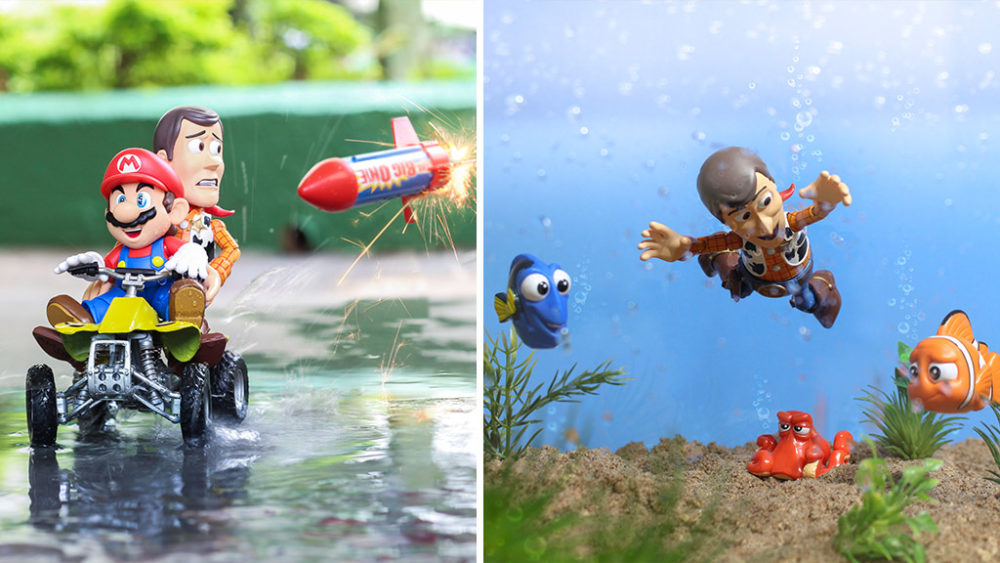
Woody from Toy Story has gone on plenty of big-screen adventures over the years, saving his fellow toys from the wrath of Sid, escaping from a nefarious teddy bear, and even learning how to fly (or fall with style) with his buddy Buzz Lightyear. But Brazilian toy photographer Jefferson Bongarthner creates a world where Woody’s adventures never end. All of Bongarthner’s joyful images feature Woody and his Toy Story companions doing everything from trying on shoes and stargazing to meeting Baby Yoda and out-racing rockets with Mario.
We chatted with Bongarthner about his journey with toy photography, his character-focused approach to the art form, his advice for new toy photographers, and more!
(Editor’s note: Portuguese is Bongarthner’s primary language. You’ll find his answers translated to English first, followed by the original Q&A in Portuguese below.)
The Pop Insider: How and when did you first get started in toy photography? Do you remember the first picture you took?
JB: It all started in 2014. I was always in love with Disney and animation, and in the drawing courses I did, I saw a way to get closer to this universe. As my drawings evolved, I felt the need to share them with other friends and I discovered the social network Instagram. At the beginning, I posted some of the drawings on my profile, @jrbonga, and while browsing Instagram I came across pictures of toys.
That caught my attention a lot. The photos were fun, the characters seem to come to life. The universe was gigantic, from simpler toys to action figures with unbelievable realism. At that moment I realized another way of approaching this universe of animation, this magical Disney-Pixar world. From that moment on, I started to research more on the subject, make contact with photographers, and understand a little more about this art, this hobby.
After a few weeks, the drawings had already been put aside and I put all my focus to finding a way to acquire a character, but it could not be any character — it needed to be something that represented me, that represented my passion for Disney. It was while revisiting childhood memories and still browsing social media that I came across the character Woody. Eureka! There was what I needed. A character who was, fun, Disney, and who would be my photo partner.
After a few days, I managed to buy a figure and I was so anxious to take the first photo, I remember it as if it were today. I took Woody, put a piece of paper with the words “Good Night” written on it in his hand, and made my first post on Instagram with my first action figure.
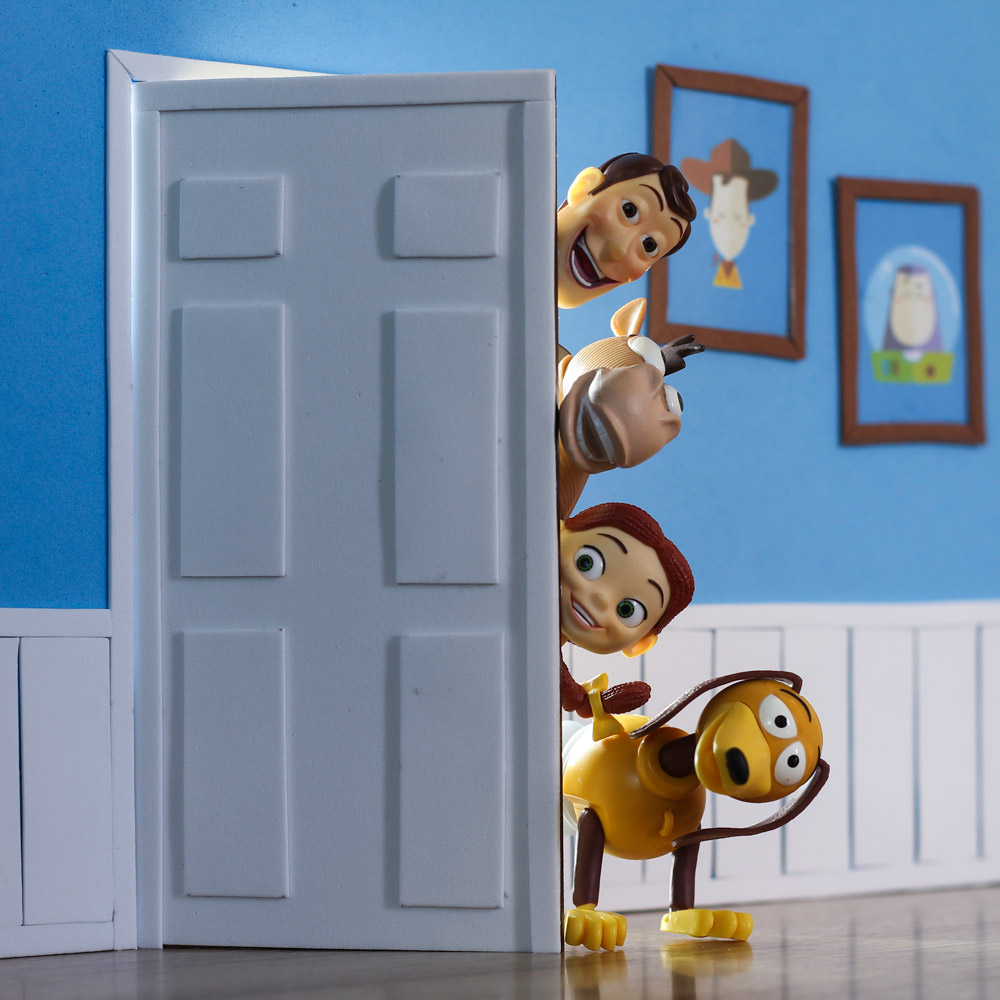
PI: What is it about Woody and the Toy Story characters that work well for toy photography?
JB: I’ve always been a big fan of Toy Story. The lightness of the film, the process of creation, and the animation has always been something that caught my attention.
When I saw some pictures of toys on social media and decided that I wanted to join this universe, I wanted to do something different. I wanted a character that represented me, that was fun, and that everyone knew and felt happy to see him. And then I came across Woody.
Yes, this was the character I was looking for. The character is known worldwide, is part of the Disney-Pixar universe that I love so much, and his personality could be transported to everyday scenes because Woody is a cowboy who could be having a coffee, watching TV — different from, for example, a dinosaur that doesn’t live in our reality. And he is a character that made, is, or will be part of some moment in people’s lives because he is so iconic and Toy Story entertains everyone, from the youngest to the oldest.
So I decided that Woody would be the protagonist of my profile and he would be representing me. Whatever I was able to do in my day-to-day life, I would transform it into a photo and Woody would represent me.
PI: Where do you get inspiration and ideas for your photos?
JB: The idea is to bring scenes from our daily life into the photos, so many of the photos are inspired by my daily life. However, a lot of days are routine, so I also watch a lot of movies and cartoons and they give me inspiration for some fun scenes and different perspectives. Sometimes I also do some crossovers between movies and characters.
PI: What have been some of the biggest challenges you’ve faced in learning toy photography and in growing your audience?
The first big challenge was to understand this new style of art. In Brazil, this art was already done by some photographers, who are now friends of mine, but this was not publicized on social media. So the challenge was to understand the concept of art, find out where to buy the toys, learn which are the best brands, and what each brand had available. Since I had chosen Woody as the protagonist, I needed to find the best doll that would allow for different poses, facial expressions and also have accessories so that I had more options when it came to creating the photos.
Another very big challenge was understanding toy photography techniques. The pictures I was taking before this didn’t need the same type of detail and framing. With the action figures, I wanted to convey emotion and bring the characters to life so that the figure was more like a person than a toy. This required a lot of study and research as well as a lot of training.
Another big challenge was showing people a different type of toy photography. I wanted to stand out among the other photographers who were already making professional-quality toy pictures.
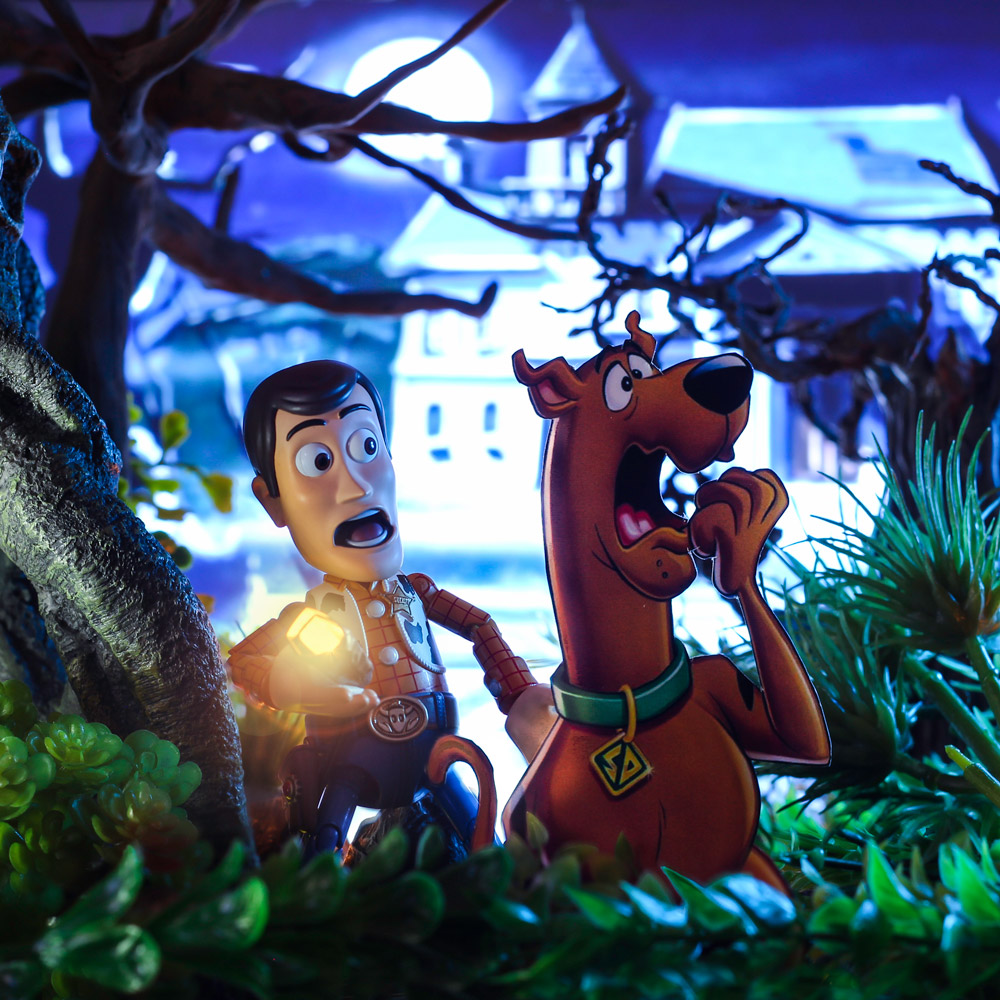
PI: What do you think makes your photos stand out from other toy photographers’ work?
JB: Taking pictures with Disney characters helps a lot because they are iconic characters that most people recognize, but bringing lightness and joy to all the photos I do is the biggest difference. My photos don’t have fight scenes, for example. I’m definitely not against fight photos and honestly I really admire my friends and fellow photographers who have created amazing poses and scenes that look like they are straight out of the movies, but I feel like my audience is more “universal.” I want to make both kids and adults smile with my pictures.
Another thing I believe that makes my pictures different is that I rarely use any photo manipulation features, that is, all the props and backgrounds in my photos are made of paper, styrofoam, or other materials — even miniatures, but I really try to avoid using Photoshop to insert additional props or images. I believe this gives me additional credibility as a photographer due to the difficulty in composing the photograph without additional special effects.
PI: You share a lot of behind-the-scenes tips and videos on your Instagram and YouTube. Why do you think it’s important to do so?
JB: I must confess that, at first, I didn’t feel comfortable sharing the behind-the-scenes look at how I make my photos. The work behind the scenes was one of the difficulties I encountered when I started with the photos. Not everyone wanted to share their tips, tricks, and techniques with me about how they made their photos. This created a barrier for me at the beginning and I realized that other people may be facing the same difficulty getting started, so I wanted to share what I learned to help other people as much as I could so they would not give up. This is a really fun thing to do, and I want to help others get started.
I believe this caught a lot of people’s attention and respect and helped me become more recognized in Brazil and other parts of the world.
Sharing the behind-the-scenes work also helps me think about and create new techniques and ideas. This leads to me improving my projects while also encouraging new photographers and collectors to enter this fun world of toy photos that people really enjoy.
Very often people who see the photos are in awe at the realism, but when they see the “making of” they are even more enchanted and it creates an even greater appreciation for the pictures and for me as a photographer. It is also very important when I go in front of different companies, brands, and magazines because they can see that my pictures are authentic and not just digital manipulation. My technique demands time, dedication, and patience, and all this work can add enormous value to a product, brand, or advertising.
PI: What are some of your favorite action figure brands to use in your photos and why?
JB: I’ll start with the miniatures. When it comes to miniatures, I don’t have a favorite brand, I am just looking for items that allow me to keep the proportions and scales uniform so that the photos are always very balanced.
That being said, my first Woody was from the Revoltech brand and I still have it with me today. I really like Revoltech because they maintain really consistent proportions in all of their characters. I try to buy their characters whenever I can.
Another brand I really like is S.H. Figuarts. The characters are very well made and they have a huge variety. Another thing I really like about them is that many of the characters are proportional to the figures from Revoltech, and in addition, it is possible to exchange the heads and bodies between them which makes it possible for me really customize the figures in my pictures.
The brand that won my heart is Herocross, which comes with an amazing line of Disney characters including a dedicated line for Toy Story. The scale is a little different from Revoltech and S.H. Figuarts, but they are very well-crafted characters. They are hybrids and have many expressions which I just love, and that allows me to make many variations in the photos.
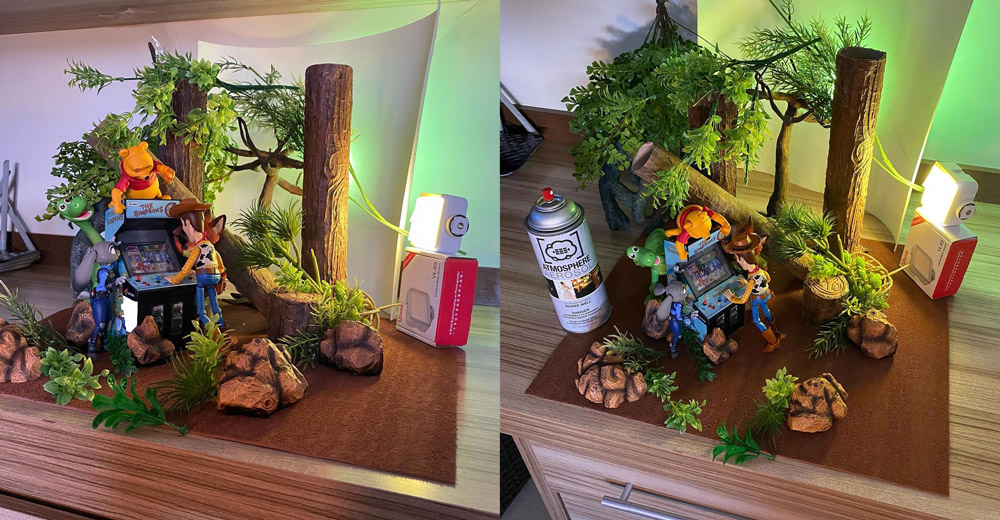
PI: Can you walk us through the process you use to set up a photo?
JB: I start with a main idea and then quickly sketch what I plan to photograph. Next, I prepare all the scenery, the various items within the scene, and add the small details and characters that will be part of the photo. As I said before, I prefer to always use physical resources to compose the photo, avoiding the need for editing.
So for example, for the creation of a scene where Woody will be swimming, I’m not going to insert a seabed in the finished photo. Instead, I prepare the scene with glass, sand, water sprays, and anything else I need so that I can create a background scene that looks like the sea, but without having to make additional edits on the computer.
Another technique I use a lot is paper prints of items and accessories and using lights to be able to simulate daylight or moonlight.
I will use Photoshop when I want to erase a wire I used to suspend a character or to remove a support I used to balance a second character, but not to create the background or other scene elements.
Additionally, I do use photo editing for lighting and sometimes color corrections because the cameras, however good they are, cannot capture everything that our eyes actually see. So I always recommend “post-processing” which are the corrections in photography that bring that more vivid color and prettier light.
PI: A lot of your photos feature miniature props, such as tiny Funko Pop! boxes. Do you make those yourself? If not, where do you get them?
JB: In 2014 when I started taking photos, and even now, the big difficulty is getting these miniatures. Here in Brazil it is very difficult to find these items and when I do, they are very expensive.
Some of the miniatures I import from other countries, some I find in toy stores. I even take trips outside my country to find different items, but even still, it all takes time and money. Nowadays I try to make my own miniatures. I use a lot of resources like cardboard and styrofoam to make some. For things like the Funko Pop! boxes, I look for the images on the internet, create the boxes in Photoshop and then print, cut, and paste everything. It takes a lot of patience!
Other miniatures are made of styrofoam, and I start by looking for ideas on the internet. Then I create them and shape them to fit my miniatures. I did this with some video games, paintings, cell phones, cameras, and other items. My plan now is to get a 3D printer – that would help a lot in creating new items.
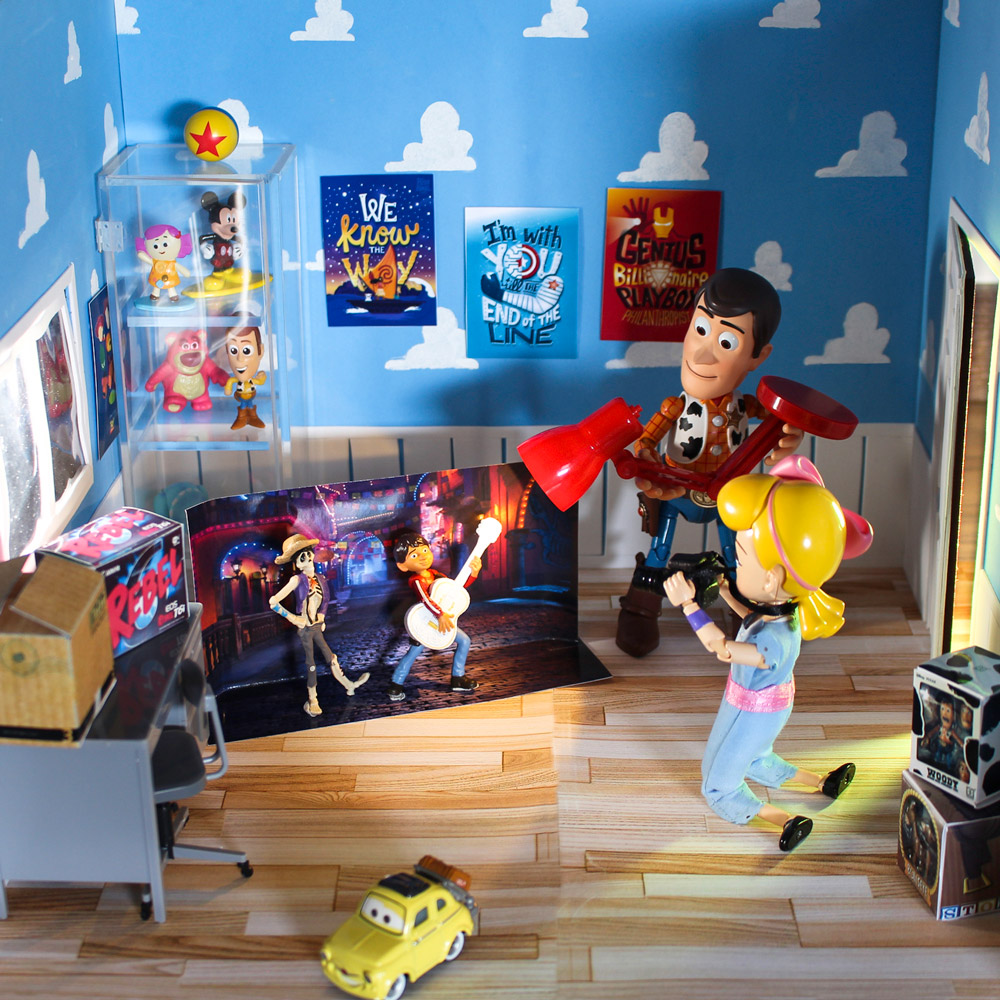
PI: What advice would you give to someone who is interested in starting toy photography?
JB: I always tell my followers, friends, and people who ask me this question: Don’t worry about having a state-of-the-art camera or a toy with a lot of intricate details. Those features are wonderful, but stick to using your creativity. You can start by taking beautiful pictures with your cell phone. Just pick a character you like, because even if it doesn’t have several articulations, it means something to you and the love and dedication you put in your photo will come through the lens even more than extra details on the toy itself.
Another tip I give is about the dioramas or scenes we use. You don’t need to have a super diorama, an incredibly produced setting. Explore your home’s garden, a colorful space in your apartment or print a background that you think is cool.
Start with the basics. You can have the best camera, the most amazing action figure, a diorama to make everyone jealous, but if you’re not creative and know how to use these tools, you won’t get a fun photo.
A simple charismatic character and a smile-making photo are worth more than a super production that does not evoke emotion in the person who sees your photo.
View this post on Instagram
PI: What is one of your favorite memories from taking toy photos?
JB: Thanks to this hobby I have had many incredible opportunities and I have met many photographers and made new friends. I have also had the opportunity to work on a lot of advertising and make contacts with many brands and stores. Taking pictures of toys has also enabled me to participate in big events and make photo exhibitions in huge malls.
I am so thankful for all of the memories and experiences along this journey, but really the recognition of people who enjoy my photos and big brands are memories that I truly cherish. I can mention a few, for example: An article was written about my story and then I got to be a part of the Orlando em Revista team. I also had the honor of having part of my work published in ExcluMagazine as well as featured in other promotions in Brazil and the world. I’ve also made partnerships with huge companies.
Above all, I get a lump in my throat when I remember my trips to Disney. I would stop in the middle of the parks, take my toys out of my backpack and while I was photographing them, kids, adults, and castmembers passing by would stop and say, “Look how amazing!” “Look mom, he’s taking a picture of Woody!” This is priceless… this affection and recognition is sensational.
Follow Bongarthner on Instagram (@jrbonga) and YouTube to see more of his work!
The Pop Insider: Como e quando você começou a fotografar brinquedos? Você se lembra da primeira foto que tirou?
JB: Tudo começou em 2014. Eu sempre fui apaixonado pela Disney e por animações e via nos cursos de desenho que fazia, uma forma de me aproximar deste universo. Com a evolução dos meus desenhos senti a necessidade de compartilha-los com outros amigos e descobri a rede social Instagram.
No inicio postei alguns dos desenhos no próprio perfil @jrbonga e navegando pela rede me deparei com fotos de brinquedos.
Aquilo me chamou muita a atenção. As fotos eram divertidas os personagens parece que ganhavam vida. O universo era gigantesco, desde brinquedos mais simples até figuras de ação com um realismo inacreditável.
Naquele instante percebi uma outra forma de me aproximar deste universo de animação, este mundo mágico Disney-Pixar.
A partir deste momento passei a pesquisar mais sobre o assunto, fazer contato com fotógrafos, entender um pouco mais sobre esta arte, este hobby.
Passado algumas semanas os desenhos já haviam sidos deixados de lado e colocado todas mais forças para encontrar um meio de adquirir um personagem, mas não poderia ser qualquer personagem, precisava ser algo que me representasse, que representasse a minha paixão pela Disney e foi quando retomando as memorias de criança e navegando alinda pelas redes sociais me deparei com o personagem Woody.
Eureca… estava aí o que eu precisava. Um personagem, divertido, Disney e que seria o meu parceiro de fotos.
Depois de alguns dias consegui comprar o personagem e a ansiedade era tanta para fazer a primeira foto que me recordo como se fosse hoje como à fiz. Peguei o personagem, coloquei em sua mão um pedaço de papel escrito “Boa Noite” e fiz o meu primeiro post no Instagram com o meu primeiro Aciton Figure.
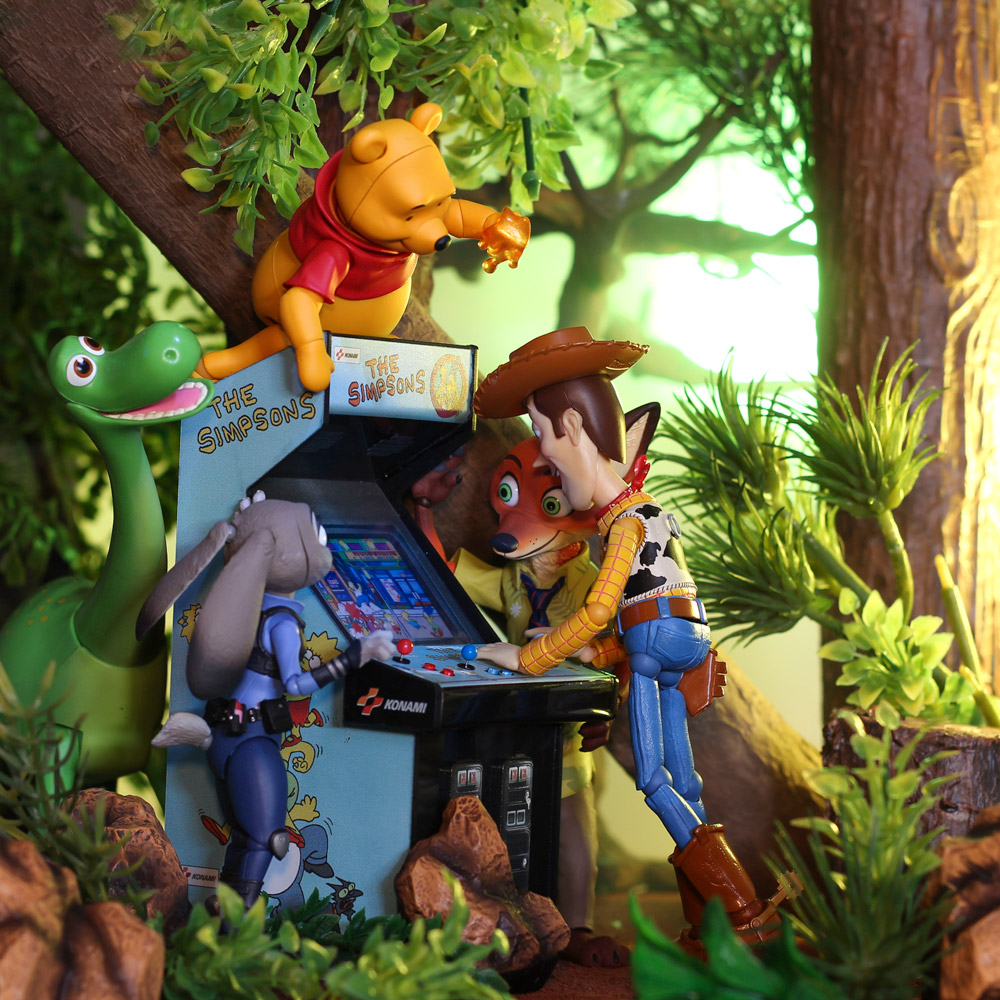
PI: Como você decidiu fazer de Toy Story o foco de todas as suas fotos? O que esses personagens tem que fazem eles funcionarem bem para a fotografia de brinquedos?
JB: Sempre fui muito fã de Toy Story. A leveza do filme, o processo de criação e animação sempre foi algo que me chamou a atenção.
Quando vi algumas fotos de brinquedos nas redes sociais e decidi que queria entrar para este universo eu queria fazer algo diferente. Eu queria um personagem que me representasse, que fosse divertido e que todos conhecesse e se sentissem felizes ao vê-lo. e então me deparei com o Woody.
Sim este era o personagem que eu tanto procurava. O personagem é conhecido mundialmente, faz parte do universo Disney-Pixar que tanto amo e a sua personalidade poderia ser transportada para cenas do dia a dia pois o Woody é um cowboy que poderia estar tomando um café, assistindo uma televisão, diferente por exemplo de um dinossauro que foge da nossa realidade e além de tudo isso é um personagem que fez, faz ou fará parte de algum momento da vida das pessoas por ser tão icônico e que diverte desde os mais pequenos até os mais velhos.
Então decidi que o Woody seria o protagonista do meu perfil e ele estaria me representando. Tudo aquilo que eu fosse capaz de fazer no meu dia a dia eu iria transformar em foto e o Woody me representaria.
PI: De onde você tira inspiração e ideias para suas fotos?
JB: A ideia do perfil é trazer para dentro das fotos cenas do nosso cotidiano, então muitas das fotos me inspiro no meu dia a dia, mas muitos dos nossos dias são rotineiros e as ideias vão acabando então assisto muitos filmes, desenhos animados e com isso consigo captar algumas cenas divertidas, alguns insides diferentes e até mesmo fazer alguns crossovers entre filmes e personagens.
PI: Quais foram alguns dos maiores desafios que você enfrentou ao aprender fotografia de brinquedos e aumentar seu público?
JB: No início da criação do meu perfil o primeiro grande desafio foi entender este novo estilo de arte. No Brasil esta arte já era feita por alguns fotógrafos, hoje amigos meus, porem isso não era divulgado em redes sociais. Então o desafio era entender o conceito da arte, descobrir onde comprar os personagens, quais as melhores marcas, o que cada marca poderia me proporcionar e uma vez que eu havia escolhido o Woody como protagonista buscar o melhor personagem para que conseguisse em um único boneco ter poses, expressões faciais e acessórios para que as possibilidades de foto fossem grandes e variáveis.
Outro desafio muito grande foi a compreensão sobre as técnicas de fotografia. Antes tirava foto das coisas sem muito critério e com os actions figures eu precisava agora passar emoção e deixar o mais próximo da nossa realidade uma foto onde o personagem principal não era um pessoas e sim um brinquedo. Isso me exigiu muito estudo e pesquisa além de muito treino.
Acredito que outro grande desafio foi mostrar para as pessoas uma forma diferente de fotografia. Eu precisava me destacar entre os fotógrafos que já trabalhava com esta arte, os fotógrafos profissionais e todo os outros conteúdos existentes na internet e foi onde apostei em trazer a todo instante: fotos divertidas para todos os públicos, fotos do cotidiano, fotos sem manipulação gráfica. Tudo isso venho trazendo ate hoje, o que tem feito com que as pessoas se identifiquem com as fotos e se divirta, pois consegue ver a si mesmo através do Woody em algumas cenas.
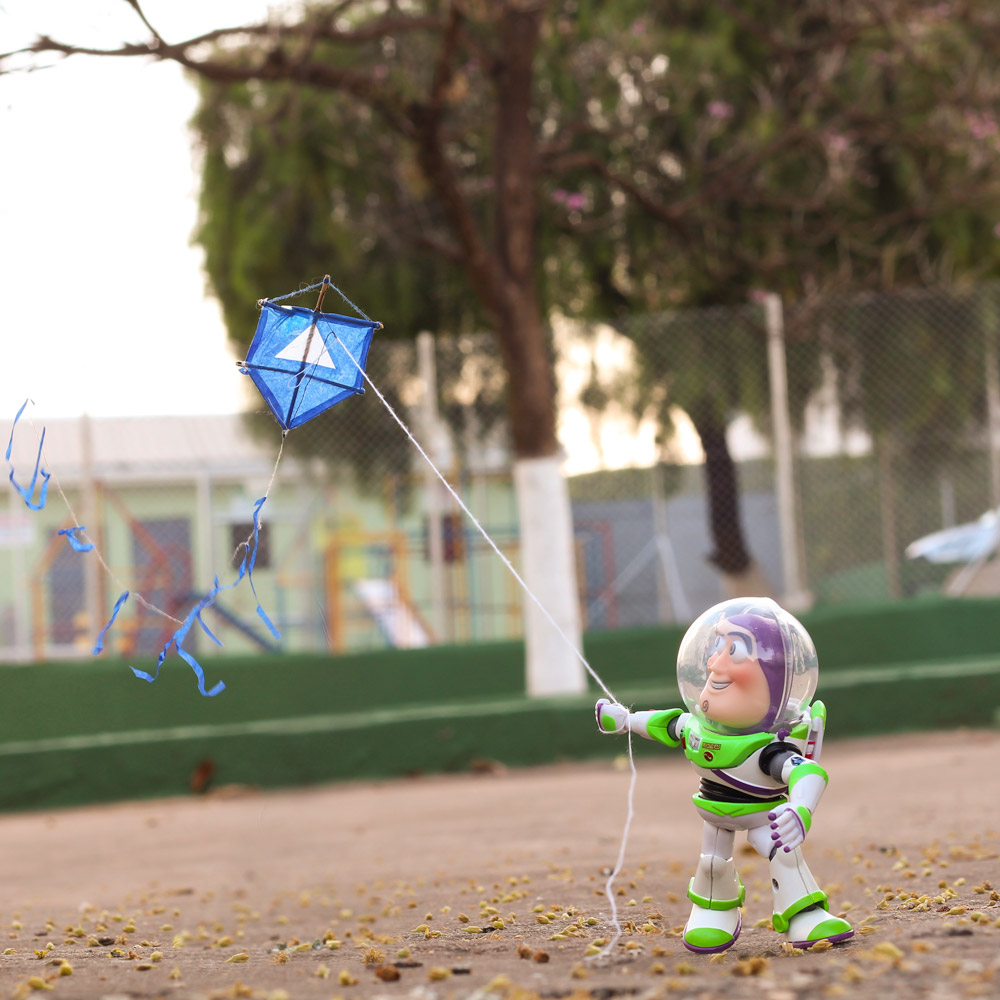
PI: O que você acha que faz suas fotos se destacarem do trabalho de outros fotógrafos de brinquedos?
JB: O fato de fazer fotos com personagens da Disney isso ajuda bastante pois são personagens icônicos e que agrada um publico muito grande, mas trazer para todas as fotos que faço a leveza e a alegria é o grande diferencial. Minhas fotos não tem cenas de lutas por exemplo, não sou contra este tipo de foto e tenho uma admiração enorme pelos amigos e fotógrafos que tem uma expertise em fazer poses incríveis, cenas que parecem sair de dentro de filmes, mas meu público é “universal” então busco agradar a todos e acredito muito que cenas engraçadas eu consiga tirar um sorriso desde uma criança até um adulto que acabou e chegar do seu trabalho extremamente cansado.
Outro ponto que acredito ser um grande diferencial é usar o mínimo ou não usar o recurso de manipulação da foto, ou seja, todos os elementos encontrados na minha foto são reais, feitos de papel, isopor, miniaturas, ou qualquer outro tipo de recurso, mas evitando-se ao máximo inserir um objeto por meio de Photoshop por exemplo, o que me dá mais credibilidade e visualização devido a dificuldade em compor a fotografia.
PI: Você compartilha muitas dicas e vídeos dos bastidores em seu Instagram e YouTube. Por que você acha que é importante fazer isso?
JB: Confesso que no inicio eu não me sentia a vontade em compartilhar os bastidores das minhas fotos, pois foi uma das dificuldades que encontrei quando comecei com as fotos. Nem todos queria compartilhar suas dicas, seus truques e seu conhecimento comigo sobre suas fotos e como faziam elas.
Isso tudo me criou uma certa barreira no inicio e percebi que a dificuldade que eu tive alguém poderia estar tendo naquele mesmo momento e de repente poderia estar desistindo de entrar neste universo tão divertido por não ter alguém que compartilhasse e ajudasse ele a dar os primeiros passos.
Então como eu queria fazer fotos diferentes eu decidi ter uma postura diferente e decidi compartilhar o que eu sabia e já tinha aprendido. Isso me fez ter mais credibilidade de admiração das pessoas, me fez a me tornar referencia no Brasil e ser também mais reconhecido fora do meu país.
Compartilhar os bastidores me ajuda a estar pensando e criando sempre coisas novas, me ajuda a melhorar meus projetos, ajuda a incentivar novos fotógrafos e colecionadores a entrar neste mundo tão divertido além de ser uma parte da fotografia que chama muito a atenção das pessoas.
Muitas vezes a foto deixa a pessoa maravilhada, mas quando ela vê os bastidores ela se encanta ainda mais, cria uma admiração pela arte e por mim ainda maior e faz com que ela passe a me acompanhar, além de isso ser importante em meu processo de criação também frente as empresas, marcas e revistas entre outros pois podem ver que não é uma foto digital, é uma técnica que demanda tempo, dedicação, paciência e que todo este trabalho pode agregar um valor enorme a um produto, marca, publicidade.
PI: Quais são algumas de suas marcas favoritas de bonecos de ação para usar em suas fotos e por quê?
JB: Vou começar pelas miniaturas. Em se tratando de miniaturas eu não tenho uma marca preferida, procuro sempre aqueles itens que eu consiga manter as proporções e escalas para que as fotos fiquem sempre bem harmoniosas.
Sobre os actions figures o meu primeiro Woody foi da marca Revoltech e tenho ele ate hoje comigo. Gosto muito da marca e por ela sempre manter uma proporção muito legal em seus personagens eu procuro comprar os personagens desta linha.
Outra marca que gosto muito é a SH Figuarts. Os personagens são muito bem feitos além da variedade enorme que podemos encontrar na SH Figuarts. Outra coisa muito legal que faz com que eu sempre tenha personagens desta linha também é que muitos dos personagens são bem proporcionais aos personagens da Revoltech e além disso é possível fazer a troca das cabeças e corpo entre eles o que me possibilita com apenas 1 personagem, transforma-lo em outros.
E agora uma marca que ganhou meu coração (rsrs) é a Herocross, que venho com uma linha incrível de personagens Disney e uma linha dedicada para Toy Story. A escala é um pouco diferente da Revoltech e SH Figuarts, mas são personagens muito bem trabalhados, são híbridos e que possui muitas expressões e isso me deixa fascinado e me possibilita fazer muitas variações nas fotos.
View this post on Instagram
PI: Você poderia explicar sobre o processo que você usa para configurar uma foto?
JB: Eu começo a foto com a ideia central. Em alguns momentos eu desenho a cena, como um pequeno rascunho do que pretendo fotografar.
Depois preparo todo o cenário, itens para compor a cena, os pequenos detalhes e personagens que irão fazer parte da foto.
Como havia dito, o meu grande diferencial é usar sempre recursos físicos para compor a foto evitando o isso de edição.
Então por exemplo, para a criação de uma cena onde o Woody estará nadando, não vou inserir um fundo do mar na foto pronta, eu preparo o cenário com vidros, areia, borrifadores de água, tudo para que eu consiga uma cena de fundo do mar porem sem edições no computador.
Uma outra técnica que uso bastante são impressões em papel de itens e acessórios, utilização de luzes para poder simular a luz do dia ou a luz da lua.
O uso do Photoshop eu uso quando quero apagar um arame que usei para suspender um personagem, ou retirar um suporte que usei para equilibrar um segundo personagem.
Porem algo que se confunde muito é a questão de edição, quando se fala em inserir itens que não existia em sua foto e edição ao você usar recursos de softwares por exemplo para ajustar a tonalidade da sua foto, o contraste, o brilho.
A edição da foto neste sentido eu faço uso sim, pois as câmeras por melhores que elas sejam não consegue captar tudo o que de fato os nosso olhos enxergam então sempre é recomendado o que chamamos de pós processamento que é as correções na fotografia para trazermos aquela cor mais viva, aquela luz mais bonita por exemplo
PI: Muitas das suas fotos apresentam acessórios em miniatura, como as minúsculas Funko Pop! caixas. Você mesmo faz isso? Se não, onde você os consegue?
JB: Hoje aqui no Brasil assim como em 2014 quando comecei a fazer as fotos, a grande dificuldade é conseguir estas miniaturas. Aqui no Brasil é muito difícil encontrar estes itens e quando encontramos é muito caro.
Algumas das miniaturas eu importo de outros países, encontro em algumas lojas de brinquedos, aproveito as viagens para fora do meu país para trazer itens diferentes, mas mesmo tendo estas possibilidades, isso tudo demanda um tempo e dinheiro então, hoje em dia eu procuro fazer as minhas próprias miniaturas. Uso muito recursos como papelão, isopor para fazer alguns itens. As miniaturas de caixas, com por exemplo as de Funko Pop eu procuro as imagens na internet, monto as caixinhas no Photoshop e depois é um trabalho de paciência para imprimir, recortar e colar tudo.
Outras miniaturas feitas em isopor, por exemplo eu também vou buscando referencias na internet. Depois vou recordando e moldando para conseguir ter as minhas miniaturas como foi o caso por exemplo de alguns vídeos games, quadros, celulares, câmeras fotográficas entre outras miniaturas.
Agora a ideia é conseguir uma impressora 3D que iria ajudar bastante na criação de novos itens.
PI: Que conselho você daria a alguém que está interessado em começar a fotografar brinquedos?
JB: Sempre falo isso para meus seguidores, amigos e pessoas que me procuram e me fazem esta pergunta. O que eu sempre digo é: não precisa se apegar a ter uma câmera de ultima geração ou um personagem estilo Hot Toys por exemplo, com uma riqueza de detalhes incrível, que são pelas maravilhosas, mas que se prendam a usar a sua criatividade. Comece usando o seu celular, que alias da pra fazer fotos belíssimas com o celular, use um personagem que você goste, pois mesmo que ele não tenha diversas articulações, fazer foto com personagem que você gosta, o amor e dedicação que você deposita na sua foto é ainda maior.
Outra dica que dou e que muitos me questionam, é sobre os dioramas ou cenários que usamos. Não precisa se apegar a ter um super diorama, um cenário incrível. Explore o jardim da sua casa, um espaço colorido do seu apartamento ou imprima um background que você ache legal.
Comece com o básico. Você pode ter a melhor câmera fotográfica, o action figure mais incrível, um diorama de gerar inveja em todo mundo, mas se não for criativo e souber usar estas ferramentas não vai conseguir uma foto divertida.
Vale mais um personagem simples, carismático e uma foto de tirar sorriso do que uma super produção que não desperta emoção na pessoa que vê sua foto.
PI: Qual é uma das suas lembranças favoritas tirando fotos de brinquedos?
JB: Graças a este hobby tive muitas oportunidades incríveis. Conheci muitos fotógrafos e amigos.
Tive oportunidade de fazer muitas publicidades, ter contato com muitas marcas e lojas.
Fazendo as fotos de brinquedos pude participar de grandes eventos, fazer exposições fotográficas em shoppings enormes.
Todas estas são lembranças que me marca muito e que tenho um carinho muito grande por cada momento deste, mas acredito que o reconhecimento das pessoas e de grandes marcas são lembranças que carrego com um carinho especial e posso citar algumas como por exemplo.
Ter matéria sobre minha história e depois fazer parte da equipe da revista Orlando em Revista. Poder ter a honra de ter parte do meu trabalho divulgado na revista ExcluMagazine entre outras divulgações no Brasil e no mundo além de ter feito parcerias com empresas enormes, mas acredito que as lembranças que me da um nó na garganta ainda é quando lembro das viagens a Disney e dos minutos que tirava para parar no meio dos parques, tirava meus toys da mochila e em quanto fotografava eles crianças, adultos, castmembers passam e diziam: “olha que incrível”, “olha mãe ele esta fazendo foto do Woody”… isso não tem preço… este carinho e reconhecimento é sensacional.
